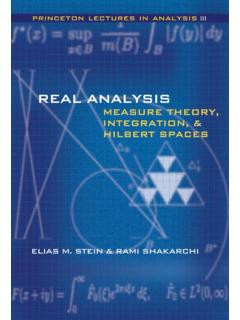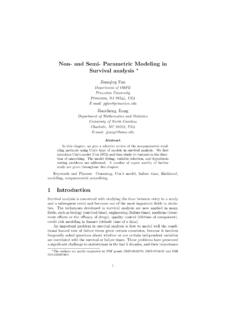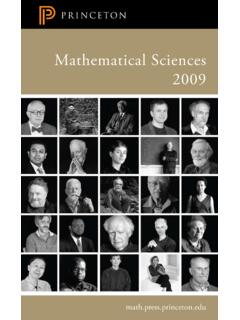Transcription of Algorithms Video Lectures ISBN: 9780134384436 August 2015
1 Algorithms Video Lectures isbn : 9780134384436 August 2015 These Video Lectures are based on the Algorithms course that was developed at princeton University by Robert Sedgewick and Kevin Wayne in conjunction with their textbook Algorithms , Fourth Edition, and their online content at The course has been taught for decades around the world and has been adapted as an exemplar course in the 2013 ACM-IEEE curriculum. Recorded in a studio, these videos provide another perspective on the material. As with any Lectures , they are intended to introduce the material and inspire further study. They make extensive use of visualizations and dynamic simulations that could not be included in printed media. Students and professionals can use the Lectures for self-study, and instructors can use them as the basis for teaching a course.
2 Generally, the Lectures cover the material in the order presented in the book, though some book topics have been combined, rearranged, or omitted in the Lectures . The following outline includes suggested readings from Algorithms , Fourth Edition, and links to online content on the companion site. Introduction (9:22) lecture 1 suggested reading: Chapter 1, section Online content: lecture 1: Union-Find. We illustrate our basic approach to developing and analyzing Algorithms by considering the dynamic connectivity problem. We introduce the union-find data type and consider several implementations (quick find, quick union, weighted quick union, and weighted quick union with path compression). Finally, we apply the union-find data type to the percolation problem from physical chemistry.
3 Dynamic Connectivity (10:22) Quick Find (10:18) Quick Union (7:50) Quick-Union Improvements (13:02) Union-Find Applications (9:22) lecture 2 suggested reading: Chapter 1, section Online content: lecture 2: Analysis of Algorithms . The basis of our approach for analyzing the performance of Algorithms is the scientific method. We begin by performing computational experiments to measure the running times of our programs. We use these measurements to develop hypotheses about performance. Next, we create mathematical models to explain their behavior. Finally, we consider analyzing the memory usage of our Java programs. Introduction to Analysis of Algorithms (8:14) Observations (10:05) Mathematical Models (12:48) Order-of-Growth Classifications (14:39) Theory of Algorithms (11:35) Memory (8:11) lecture 3 suggested reading: Chapter 1, section Online content: lecture 3: Stacks and Queues.
4 We consider two fundamental data types for storing collections of objects: the stack and the queue. We implement each using either a singly-linked list or a resizing array. We introduce two advanced Java features generics and iterators that simplify client code. Finally, we consider various applications of stacks and queues ranging from parsing arithmetic expressions to simulating queueing systems. Stacks (16:24) Resizing Arrays (9:56) Queues (4:33) Generics (9:26) Iterators (7:16) Stack and Queue Applications (13:25) lecture 4 suggested reading: Chapter 2, section Online content: lecture 4: Elementary Sorts. We introduce the sorting problem and Java's Comparable interface. We study two elementary sorting methods (selection sort andinsertion sort) and a variation of one of them (shellsort).
5 We also consider two Algorithms for uniformly shuffling an array. We conclude with an application of sorting to computing the convex hull via the Graham scan algorithm . Introduction to Sorting (14:43) Selection Sort (6:59) Insertion Sort (9:28) Shellsort (10:48) Shuffling (7:39) Convex Hull (13:50) lecture 5 suggested reading: Chapter 2, section Online content: lecture 5: Mergesort. We study the mergesort algorithm and show that it guarantees to sort any array of N items with at most NlgN compares. We also consider a nonrecursive, bottom-up version. We prove that any compare-based sorting algorithm must make at least NlgN compares in the worst case. We discuss using different orderings for the objects that we are sorting and the related concept of stability.
6 Mergesort (23:54) Bottom-up Mergesort (3:20) Sorting Complexity (9:05) Comparators (6:43) Stability (5:39) lecture 6 suggested reading: Chapter 2, section Online content: lecture 6: Quicksort. We introduce and implement the randomized quicksort algorithm and analyze its performance. We also consider randomized quickselect, a quicksort variant which finds the kth smallest item in linear time. Finally, consider 3-way quicksort, a variant of quicksort that works especially well in the presence of duplicate keys. Quicksort (19:33) Selection (7:08) Duplicate Keys (11:25) System Sorts (11:50) lecture 7 suggested reading: Chapter 2, section Online content: lecture 7: Priority Queues. We introduce the priority queue data type and an efficient implementation using the binary heap data structure.
7 This implementation also leads to an efficient sorting algorithm known as heapsort. We conclude with an applications of priority queues where we simulate the motion of N particles subject to the laws of elastic collision. APIs and Elementary Implementations (12:52) Binary Heaps (23:36) Heapsort (14:29) Event-Driven Simulation (22:38) lecture 8 suggested reading: Chapter 3, sections and Online content: and lecture 8: Elementary Symbol Tables. We define an API for symbol tables (also known as associative arrays) and describe two elementary implementations using a sorted array (binary search) and an unordered list (sequential search). When the keys are Comparable, we define an extended API that includes the additional methods min, max floor, ceiling, rank, and select.
8 To develop an efficient implementation of this API, we study the binary search tree data structure and analyze its performance. Symbol Table APIs (21:30) Elementary Implementations (9:03) Ordered Operations (6:26) Binary Search Trees (19:56) Ordered Operations in BSTs (10:31) Deletion in BSTs (9:52) lecture 9 suggested reading: Chapter 3, section Online content: lecture 9: Balanced Search Trees. In this lecture , our goal is to develop a symbol table with guaranteed logarithmic performance for search and insert (and many other operations). We begin with 2-3 trees, which are easy to analyze but hard to implement. Next, we consider red-black binary search trees, which we view as a novel way to implement 2-3 trees as binary search trees. Finally, we introduce B-trees, a generalization of 2-3 trees that are widely used to implement file systems.
9 Search Trees (16:55) Red-Black BSTs (35:30) B-Trees (10:36) lecture 10: No suggested reading or online content references for this lecture lecture 10: Geometric Applications of BSTs. We start with 1d and 2d range searching, where the goal is to find all points in a given 1d or 2d interval. To accomplish this, we consider kd-trees, a natural generalization of BSTs when the keys are points in the plane (or higher dimensions). We also consider intersection problems, where the goal is to find all intersections among a set of line segments or rectangles. Range Search (8:51) Line Segment Intersection (5:46) Kd-Trees (29:07) Interval Search Trees (13:47) Rectangle Intersection (8:10) lecture 11 suggested readings: Chapter 3, sections and Online content: and lecture 11: Hash Tables.
10 We begin by describing the desirable properties of hash functions and how to implement them in Java, including a fundamental tenet known as the uniform hashing assumption that underlies the potential success of a hashing application. Then, we consider two strategies for implementing hash tables separate chaining and linear probing. Both strategies yield constant-time performance for search and insert under the uniform hashing assumption. We conclude with applications of symbol tables including sets, dictionary clients, indexing clients, and sparse vectors. Hash Functions (18:13) Separate Chaining (7:28) Linear Probing (14:37) Context (10:09) Sets (5:04) Dictionary Clients (5:40) Indexing Clients (8:57) Sparse Vectors (7:41) lecture 12 suggested reading: Chapter 4, section Online content: lecture 12: Undirected Graphs.



















